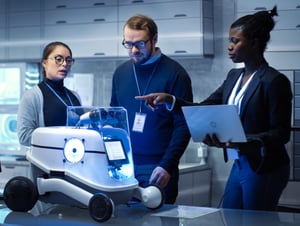Posted by Mike Jones ● August 5, 2021
5 Tips for Creating Engaging Corporate IT Training for Engineers
 Having trouble with your corporate IT training program? You’re not alone. Here’s how to create a practical training program that makes your engineers more focused and efficient.
Having trouble with your corporate IT training program? You’re not alone. Here’s how to create a practical training program that makes your engineers more focused and efficient.
At its core, corporate IT training is any form of training that introduces or supports the various computer systems and software tools used by employees—especially engineers. Keeping your people up to date with current best practices and processes is a critical part of operations. Sometimes, it can even be a major differentiator.
In short, it’s essential you get training right.
But first, you need to assess your engineers’ current level of engagement.
How to Know if Your Engineers are Engaged
You can get a good idea of engagement through a few methods of observation and tracking. If any of these problems arise, then you probably need to revise your training to make it more relevant to your engineers.
Low Adoption Rate
The goal of training is to change the way things are done. You can gauge this through activity tracking and behavior auditing. Check in with them and see if they’re adopting the new process. If they aren’t, ask why and take their feedback as an input for future changes to your training.
Not Completing the Training
Another way to gauge training effectiveness is by looking at how many people complete it. If you have an LMS, it’s easy to check the metrics. For example, completion rate, time to complete and session time will all inform how well your engineers are engaging with the training. Depending on your system, you can also identify where you might be losing people if they aren’t completing the full training. With this data at hand, your improvements can be more targeted.
In-Person? Read the Room
If you’re training in person, you can simply read the room. Are people staying on task or are they browsing distracting websites? Are they taking notes or tuning out? It’s important to pay attention to these things.
And if you’re in a computer lab, you may be able to use a tool that allows you to measure and track time and activity on screens.
Without taking action on this kind of critical feedback, your engineers will remain disinterested—and your training program will remain ineffective.
So, how do you engage them?
5 Ways to Engage Your Engineers with Corporate IT Training
Engineers are hands-on, technical people who must work with complex concepts and solve challenging problems. They don’t want to be handed an A-to-Z technical manual about a new system or process. They want IT training that’s grounded in practical skills, on-the-job tasks, and real-world examples.
Here’s what to do.
#1. Acknowledge Their Existing Experience
Engineers come with their own knowledge and experience about how to complete tasks. Even engineers fresh out of college come with valuable knowledge and experience. This existing knowledge should inform your training design.
Also, corporate IT training should be grounded in the context of real work applications. All training should be centered around what the old process was and how the new process changes things for the better. You need to establish value in the training, so your engineers know what’s in it for them.
To do this, interview a few of your potential and recent learners to see what they think about the challenge(s) they face on-the-job and how they feel the software helps or hinders their work. Use that perspective to influence the design of your training program by showing why a particular update or new piece of software improves on what they already know and how it will help them.
#2. Emphasize Hands-On Application
 Engineers are more likely to adopt new processes if they’re given the opportunity to get experience actually completing the work with the new process. Don’t miss out on the chance to physically engage your engineers in the work. Rooting their learning experience in real-world scenarios with hands-on application of skills will increase adoption and decrease required change management.
Engineers are more likely to adopt new processes if they’re given the opportunity to get experience actually completing the work with the new process. Don’t miss out on the chance to physically engage your engineers in the work. Rooting their learning experience in real-world scenarios with hands-on application of skills will increase adoption and decrease required change management.
#3. Focus On Need to Know Vs. Nice to Know
Many companies assume that learners must be experts in the new software or system top to bottom. This is a common pitfall that is bound to disengage your engineers during training.
Instead, carefully evaluate what is mission-critical need-to-know versus nice-to-know information. If they can still be successful without knowing it, leave it out.
#4. Keep Learning Chunks Small
Instead of overly complex and large trainings with encyclopedic material, keep it to bite size chunks that focus on the work, not the system. Microlearning sessions give people a chance to engage in targeted learning experiences. Instead of slogging through hours long training sessions, they get exactly what they need just in time and can refer back to it more easily, later.
This model makes training more digestible, and makes it easy for people to reference the material on the job.
#5. Provide Opportunity for Additional Support
Training alone doesn’t always meet the needs of the learner. Planning for additional support beyond formal training oftentimes will make or break your learner’s success. Knowing how and where to get help provides a safety net that gives people confidence knowing they can get additional support if questions or challenges arise.
Conclusion
Engineers are smart people. Their training should reflect that. Keep the training practical and focused on the work – not the tool or system. Apply some of these tips to your training and you’re bound to see improvements in engagement and completion rate.
